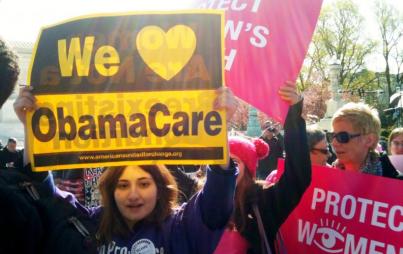
In the four years since it passed into law, the Affordable Health Care Act has been bloodied, bludgeoned, badgered and spit on—but despite the efforts of its most violent critics, it will not die. At some point, though, you have to wonder if death is actually any worse a state than its current one: gasping for air while tied up to test tubes in the florescent-lit ICU.
Recently, the law took yet another hit when SCOTUS sanctioned employers to deny reproductive-care coverage based on religious beliefs. Now, the D.C. District Circuit of Appeals has rendered a ruling that many consider an even larger crushing blow: Tax credits available under the health-care law may be provided only to residents of states that set up their own marketplaces. This means that in the 27 largely Republican-led states that have opted out of state exchanges, low-income people would miss out on critical credits to make coverage affordable.
The ruling contradicts a separate one in Richmond, VA., which claimed the Obama administration has the right to provide subsidies nationally. With conflict brewing, there's talk that this could be yet another Obamacare decision that ends up at the feet of the Supreme Court.
Of the many hits and kicks the act has suffered, this has the potential to be the most damaging yet.
Just the Facts Ma'am
First, a little background: When the Affordable Care Act passed, it was done in response to a perfect storm of rising rates and flat or decreasing incomes, which put insurance out of reach for an increasing number of people. Between 2001 and 2005, the amount people paid for health insurance increased 30 percent, yet income only increased 3 percent. Not surprisingly, the number of uninsured nearly doubled between 2003 and 2010, from 16 million to 29 million, with the low-income community particularly unable to access basic health services.
Subsidies were one way the law sought to make insurance more affordable, thereby stemming the tide of the uninsured. And while certainly imperfect, the law has shown signs of success on that front. In the two years after the law passed, the number of uninsured essentially stagnated for the first time in several years, shifting slightly to 30 million.
Removing credits could have—as the Washington Post put it—a "profound effect" on what people pay for coverage, which could reverse this crucial progress.
To wit: More than 90% of people in states that don't have state exchanges bought health plans with the help of credits. This year, on average, these subsidies lowered premiums from an average price of $345 per month to an average of just $69. Adding insult to injury? Those who will no longer be able to afford coverage without subsidies will be forced to pay the federal penalty for not having coverage, which starts at $95 or 1 percent of income.
At this point, it seems pretty clear that the act will not entirely go away. But if the law can no longer ensure vital health services to all employees—regardless of how devout their corporate bosses are—and if it can no longer promise affordable health care in more than half the nation's states, you have to wonder what's really being preserved.
The law's opponents haven't won the war. But they've won enough battles to make the impacts just as chilling.
Image: ThinkStock






